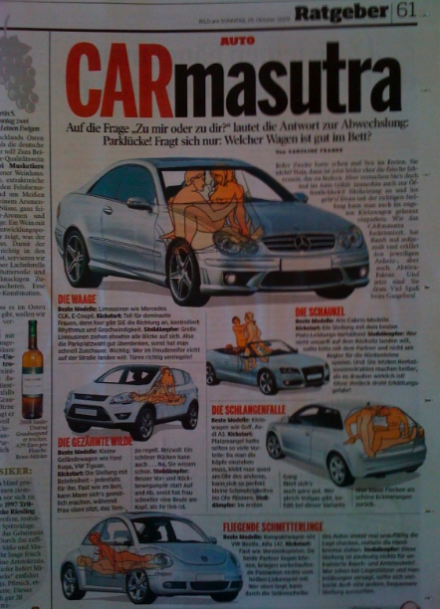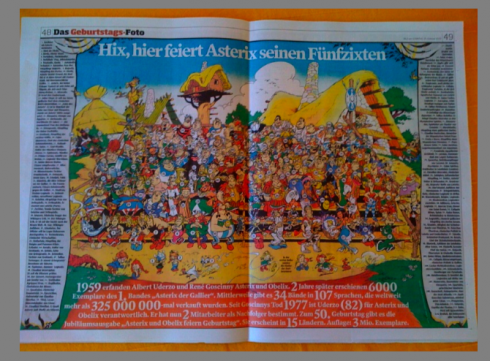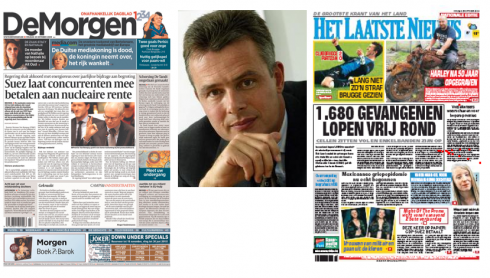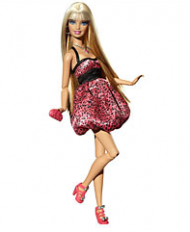Updated Sunday, Oct. 25, 04:21 EST
TAKEAWAY: Innovating and creating new content, design or sections does not mean dragging a publication away from its core market. A new book deals with the subject.


Front page of today’s Bild am Sonntag

Sex in the parking lot? Leave it to those Bild am Sonntag guys to take info graphics to the next orgasmic heights, with the irresistible headline: Carmasutra

In the news: well, it is Madonna’s daughter, Lourdes (Lola) Leon, striking a pose. Bild’s headline: What’s coming to us? Mama reloaded?

Bitches of the week? Only Bild am Sonntag would get away with this headline and story. Enjoy!

em>Of course, Jacky likes any story that includes a fellow dog: Man, Dog and the Path to Freedom, reads the headline

Double page illustration: Asterix the character turns 50
For more information about Asterix
Who is Jacky?
Jacky belongs to Frank Deville. The Luxembourg-based pooch is an “avid reader” of the German newspaper, Bild Am Sonntag. Every Sunday Jacky picks stories and interesting graphics in Bild Am Sonntag , the German newspaper.
In Brussels: staying in character

Van Thillo and two of his titles: De Morgen and Het Laatste Nieuws
Here I was, sitting in the Brussels office of that most innovative of media CEOs, Christian Van Thillo,Chief Executive Officer of Aurex-De Persgroep (I met him when he was a graduate student at Duke University about 20 years ago, then got to work with him with several projects, including Het Laatste Nieuws, De Morgen—of Brussels—and Het Parool-of Amsterdam).
Christian had laid out several newspapers on his work table, and was telling me the success of his Belgian dailies.
I told him that I was not surprised, as I remember that any project with him begins with a very clear mandate that focuses each publication for its audience. De Morgen is contemporary, elegant, and appeals to youngish readers with an education; its sister paper, Het Laatste Niews is more of a popular read, complete with large headlines and photos and content that titillate.
Each product has its target audience, and each knows what it is and how to achieve its mission. Neither one of these papers has pretensions beyond what it is. There lies the success of these titles.
Companies and image
So it was coincidental that I was having this conversation with Van Thillo at the same time that I was reading
portions of a book by Kevin Maney titled Trade-Off: Why Some Things Catch On, and Others Don’t which deals with precisely this topic. Maney’s thesis: The secret of success is deciding which type of product you are selling and staying true to that goal.
When it comes to newspapers, the newspaper that is for everybody (old notion) ends up being for nobody. Maney draws an analogy between an elite restaurant and a corner McDonald’s. In essence, according to Maney, if the élite restaurant opens a branch on every nearby block, it will lose its cachet as well as its customers. Likewise, if the McDonald’s starts serving pricey, five-course meals, its fans will go elsewhere in search of their Big Mac.
Van Thillo does not yet operate restaurants, but he lives by this rule, and he makes sure that everyone working for him follows it.
At a time of crisis (and we are still in a sort of end-of-the-great-recession period) much corporate strategy revolves around trying to grow a brand beyond its core market. In most cases, failure accompanies such attempts.
We don’t want the pricey Louis Vouitton bag or the Hermes scarf sold at K-Mart. We also don’t want an elite newspaper distributed free at the entrance of the subway.
Think of Die Zeit

Germany’s weekly Die Zeit: continues to innovate, but always true to its character
Germany’s Die Zeit is the intellectual’s newspaper. It is proud of it. Its journalists and editors plan each edition trying to stay two steps ahead of its educated audience (tough job), and when we first conceived a visual rethinking of that newspaper (still my most difficult project ever), we danced gingerly around each choice of typography, color, white space and story structure accent, to make sure that we did not, in any way, cheapened the quality of the product.
It has been a success story, and, on the record, the one German newspaper that has continued to grow during the past seven years, in spite of the global economic crisis, and the well known stories of newspaper circulation drops worldwide.
I attribute it to the fact that Die Zeit remained true to its identity. Its loyal readers knew that there had been change, and some did not like it, but nobody thought that this newspaper had been cheapened in any way.
The Wall Street Journal

The Wall Street Journal Europe, switched to tabloid format, but without abandoning its classic, elegant form
Same holds true for the various changes in which I was involved at The Wall Street Journal, perhaps the world’s leading financial daily, and now the largest circulation newspaper in the United States.
Yes, we introduced color. Yes, we changed many typographic components, and made some stories shorter.
We introduced more strategically placed columns of briefs. We introduced better navigational devices.
But we never lost track of the newspaper’s history, its identity, its DNA as a newspaper of record, a classic, an icon. Even when we converted the WSJ’s European and Asian editions to tabloid formats, we went to great lengths to create the classic tabloid look, one where readers would find stories to read on the front page. Again, success stories.
Change and innovation do not mean dragging the identity of a product down. Quite the contrary, the good innovators enhance what is there, performing a double act of preserving identity while making substantial changes to take the publication to the next level.
Something that Christian Van Thillo obviously keeps clearly in his mind. He is the constant innovator, perhaps one of the most forward thinking CEOs in our business, and his products thrive because his focus is steady. His publications show it.
Watch out “Fashionista” Barbie

The new Fashionista Barbie: she had those high heels on long before the girls from Sex and the City

My granddaughters Brianna Garcia, Sophia Lazaro and Angelina Barravecchio they are Barbie fans to the core

Meet MGM”s Bratz girls: pouty lips and spoiled attitude—-oh, yes, Barbie’s rivals on the toy shelves.
While on the subject of brands, and sticking to core groups, along enters Mattel’s Fashionista Barbie, what the company hopes is the “must have” doll for girls of all ages this holiday season.
I had become disengaged from the Barbie world after my daughters Ana and Elena outgrew the perky dolls with the stylish shoes. However, as fate would have it Barbie is back in my life, this time via my granddaughters Brianna, Sophia and Angelina, for whom I purchase the dolls from time to time. Thus, I was quite interested to read the Wall Street Journal article titled “Mattel gives Barbie a facelift to compete with young rivals”.
It appears that the new Barbie was beaten to the stores by two other new dolls that could threaten her resurgence as the queen of the tiara circuit.
What’s new about Fashionista Barbie? Well, the WSJ article tells us that she will wear runway-inspired outfits and has—- count them——12 movable joints that are supposed to allow girls to pose their Barbie like a super model. I can see my girls doing that already. In their case, 12 movable joins might not be enough. Try 16 next time.
Appropriate to our discussion above—-about sticking to your core as you make enhancements and innovations in a product-—Mattel must be careful not to succumb to imitating those other dolls that compete for my granddaughters’ attention, MGA’s Bratz, which come complete with a spoiled attitude (who needs that?), pouty lips (does everyone want Angelina Jolie lips?) and revealing clothes. Parents are not too fond of these dolls, but the girls seem to be, including my own.
For the sake of fidelity to the product, and because as a grandfather, I like my granddaughters playing with Barbie, and not with a doll with attitude and scanty clothing, I am hoping that Mattel will stick to innovation of the Barbie without destruction of its core market brand.
Oh, yeah, the new Barbie comes with six personalities: wild, artsy, cutesy, glamorous, sassy and girlie.
Somehow, my girls—-Brianna, Sophia and Angelina-—come with more personalities than that, but they excel in those six as well!
More importantly, even at their young age, they are already loyal consumers and they know what they want in their Barbie.
Spoiled attitude is not on the list. Mattel take notice.

Follow me at www.twitter.com/tweetsbydesign
Follow the Marios

Two Marios. Two Views.
Follow Mario Jr. and his blog about media analysis, web design and assorted topics related to the current state of our industry.
http://garciainteractive.com/
Visit Mario Sr. daily here, or through TweetsByDesign (www.twitter.com/tweetsbydesign)
In Spanish daily: The Rodrigo Fino blog
:
To read TheRodrigoFino blog, in Spanish, go:
https://garciamedia.com/latinamerica/blog/
TheMarioBlog post #405